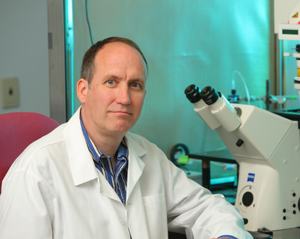 |
| Vic Rafuse is working on regenerative medicine approaches to treat ALS (NIck Pearce photo) |
People with ALS die because their nerve cells, or motor neurons, are dying. But what if there were some way to regenerate those cells?
Vic Rafuse, associate professor of anatomy and neurobiology in Dal’s Faculty of Medicine, is attempting to do just that.
He’s conducting this research over two years with a 2009 ALS Society of Canada Bernice Ramsay Discovery Grant of $100,000.
Also known as Lou Gehrig’s disease, ALS is a rapidly progressive and fatal neuromuscular disease that causes the degeneration of a specific group of nerve cells in the brain and spinal cord. As the nerve cells die, patients lose control of their muscles, making breathing and eating almost impossible.
Dr. Rafuse’s research focus is whether induced pluripotent stem (iPS) cells are a viable model system for studying sporadic ALS – the non-hereditary type that affects 95 per cent of patients – and if they could be used to treat ALS patients in a regenerative medicine approach.
“This study will examine for the first time whether iPS cell motor neurons develop the same physiological characteristics as embryo-derived motor neurons,” says Dr. Rafuse.
Using mice, Dr. Rafuse is studying whether motor neurons, derived from iPS cells, are capable of innervating muscles when transplanted into mice with ALS, and, if so, whether muscle function can be restored.
He will also test motor neurons, derived from iPS cells taken from mice with an hereditary form of ALS (i.e. the other five per cent of ALS cases), are predisposed to acquire the disease in a manner analogous to motor neurons in mice with ALS.
“It’s critical,” he says of the Bernice Ramsay Discovery Grant, announced in December. “It gives me the opportunity to devote my work to a particular project.”
Dr. Rafuse, graduate coordinator for the cross-faculty Neuroscience Institute, traces his interest in the field back to a Grade 12 science project on the regeneration of flatworms.
While he had never studied ALS, Dr. Rafuse was invited – along with others in related disciplines – to a meeting of ALS researchers a few years ago.
“I was intrigued,” he recalls. “We met patients there, too, which really motivates you.”
Denise Figlewicz, vice-president research at the Amyotrophic Lateral Sclerosis (ALS) Society of Canada, spearheaded that meeting and more like it since.
“We haven’t had a lot of neuro-developmental science in ALS up until recently, because we’ve focused on trying to keep the neurons that are there alive and functioning,” she says.
But the Discovery Grants – established just two years ago – allow a well-established researcher to test a new idea or application in his or her field, specifically related to ALS.
“The spirit of this program is to encourage promising novel research approaches that may be risky in terms of feasibility, but have potential high impact if successful,” notes Dr. Figlewicz.
“The novelty of Victor Rafuse’s grant has to do with testing out this new approach to making stem cells, and learning what you need to do to make them capable of doing something with potential therapeutic benefits,” she says. “It’s very cool.”
